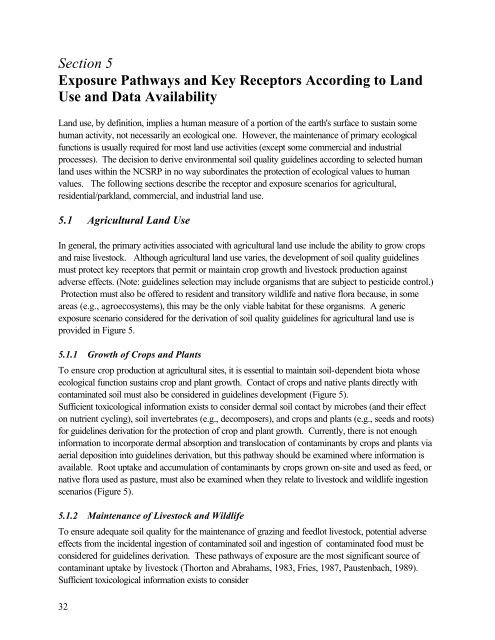Protocol for the Derivation of Environmental and Human ... - CCME
Protocol for the Derivation of Environmental and Human ... - CCME
Protocol for the Derivation of Environmental and Human ... - CCME
You also want an ePaper? Increase the reach of your titles
YUMPU automatically turns print PDFs into web optimized ePapers that Google loves.
Section 5<br />
Exposure Pathways <strong>and</strong> Key Receptors According to L<strong>and</strong><br />
Use <strong>and</strong> Data Availability<br />
L<strong>and</strong> use, by definition, implies a human measure <strong>of</strong> a portion <strong>of</strong> <strong>the</strong> earth's surface to sustain some<br />
human activity, not necessarily an ecological one. However, <strong>the</strong> maintenance <strong>of</strong> primary ecological<br />
functions is usually required <strong>for</strong> most l<strong>and</strong> use activities (except some commercial <strong>and</strong> industrial<br />
processes). The decision to derive environmental soil quality guidelines according to selected human<br />
l<strong>and</strong> uses within <strong>the</strong> NCSRP in no way subordinates <strong>the</strong> protection <strong>of</strong> ecological values to human<br />
values. The following sections describe <strong>the</strong> receptor <strong>and</strong> exposure scenarios <strong>for</strong> agricultural,<br />
residential/parkl<strong>and</strong>, commercial, <strong>and</strong> industrial l<strong>and</strong> use.<br />
5.1 Agricultural L<strong>and</strong> Use<br />
In general, <strong>the</strong> primary activities associated with agricultural l<strong>and</strong> use include <strong>the</strong> ability to grow crops<br />
<strong>and</strong> raise livestock. Although agricultural l<strong>and</strong> use varies, <strong>the</strong> development <strong>of</strong> soil quality guidelines<br />
must protect key receptors that permit or maintain crop growth <strong>and</strong> livestock production against<br />
adverse effects. (Note: guidelines selection may include organisms that are subject to pesticide control.)<br />
Protection must also be <strong>of</strong>fered to resident <strong>and</strong> transitory wildlife <strong>and</strong> native flora because, in some<br />
areas (e.g., agroecosystems), this may be <strong>the</strong> only viable habitat <strong>for</strong> <strong>the</strong>se organisms. A generic<br />
exposure scenario considered <strong>for</strong> <strong>the</strong> derivation <strong>of</strong> soil quality guidelines <strong>for</strong> agricultural l<strong>and</strong> use is<br />
provided in Figure 5.<br />
5.1.1 Growth <strong>of</strong> Crops <strong>and</strong> Plants<br />
To ensure crop production at agricultural sites, it is essential to maintain soil-dependent biota whose<br />
ecological function sustains crop <strong>and</strong> plant growth. Contact <strong>of</strong> crops <strong>and</strong> native plants directly with<br />
contaminated soil must also be considered in guidelines development (Figure 5).<br />
Sufficient toxicological in<strong>for</strong>mation exists to consider dermal soil contact by microbes (<strong>and</strong> <strong>the</strong>ir effect<br />
on nutrient cycling), soil invertebrates (e.g., decomposers), <strong>and</strong> crops <strong>and</strong> plants (e.g., seeds <strong>and</strong> roots)<br />
<strong>for</strong> guidelines derivation <strong>for</strong> <strong>the</strong> protection <strong>of</strong> crop <strong>and</strong> plant growth. Currently, <strong>the</strong>re is not enough<br />
in<strong>for</strong>mation to incorporate dermal absorption <strong>and</strong> translocation <strong>of</strong> contaminants by crops <strong>and</strong> plants via<br />
aerial deposition into guidelines derivation, but this pathway should be examined where in<strong>for</strong>mation is<br />
available. Root uptake <strong>and</strong> accumulation <strong>of</strong> contaminants by crops grown on-site <strong>and</strong> used as feed, or<br />
native flora used as pasture, must also be examined when <strong>the</strong>y relate to livestock <strong>and</strong> wildlife ingestion<br />
scenarios (Figure 5).<br />
5.1.2 Maintenance <strong>of</strong> Livestock <strong>and</strong> Wildlife<br />
To ensure adequate soil quality <strong>for</strong> <strong>the</strong> maintenance <strong>of</strong> grazing <strong>and</strong> feedlot livestock, potential adverse<br />
effects from <strong>the</strong> incidental ingestion <strong>of</strong> contaminated soil <strong>and</strong> ingestion <strong>of</strong> contaminated food must be<br />
considered <strong>for</strong> guidelines derivation. These pathways <strong>of</strong> exposure are <strong>the</strong> most significant source <strong>of</strong><br />
contaminant uptake by livestock (Thorton <strong>and</strong> Abrahams, 1983, Fries, 1987, Paustenbach, 1989).<br />
Sufficient toxicological in<strong>for</strong>mation exists to consider<br />
32
















